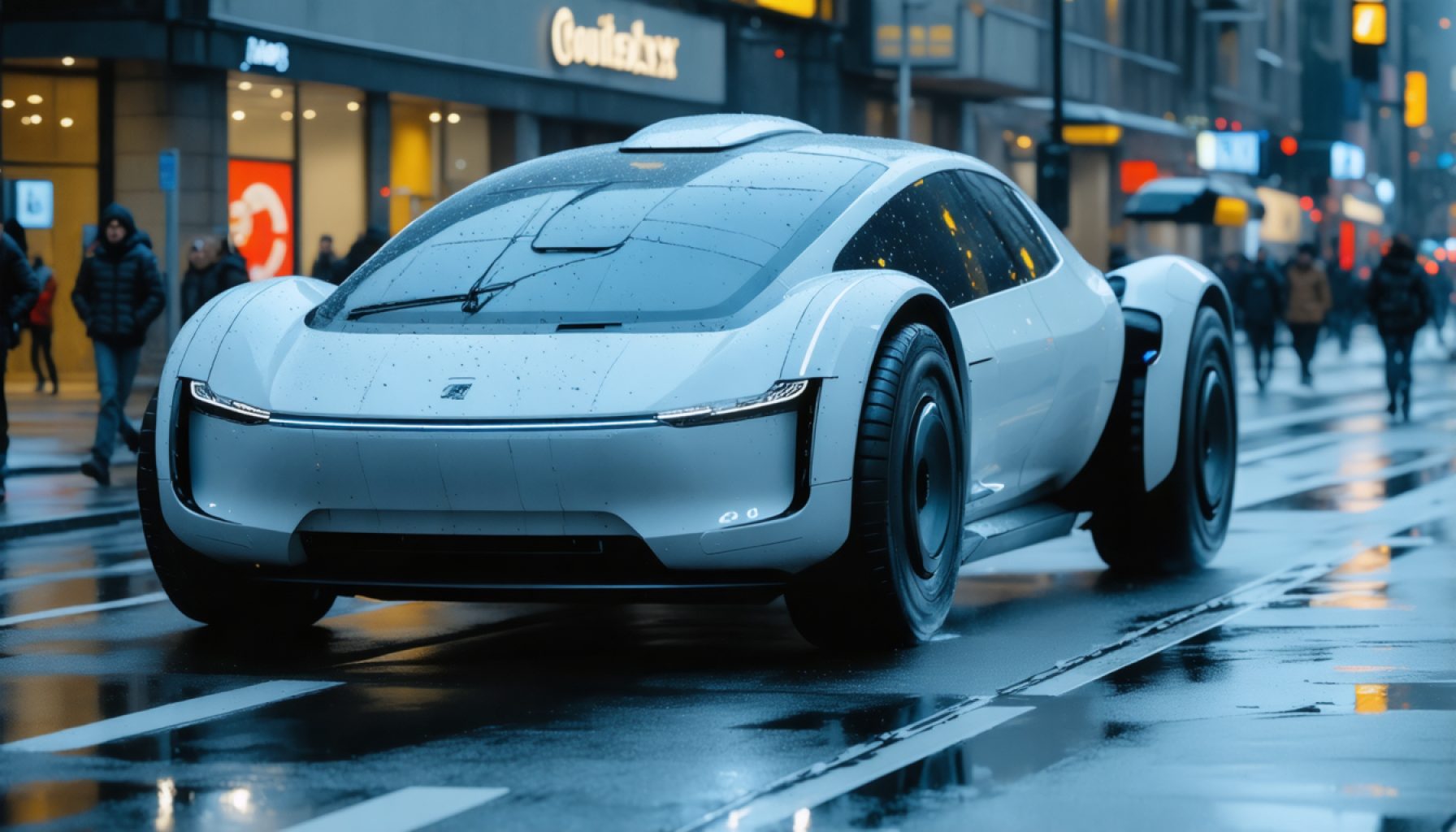
- The robotaxi market is projected to grow from USD 0.4 billion in 2023 to USD 45.7 billion by 2030, with a whopping annual growth rate of 91.8%.
- Tech giants like Waymo, Baidu, and Cruise lead the charge, illustrating autonomous vehicle technology‘s practical and safe deployment.
- Urbanization and sustainability drive the shift, with robotaxis reducing congestion and emissions, especially electric models curbing fossil fuel reliance.
- Cross-industry collaborations are enhancing autonomous tech development, signaling a shift towards shared mobility solutions.
- Regulatory approval and public trust are critical challenges, yet ongoing pilots aim to build confidence in autonomous rides.
- Robotaxis embody a fundamental change in urban mobility, pushing for cities that are smarter and cleaner.
Imagine a city where congestion and emissions have become relics of the past. In this metropolis of tomorrow, silent and efficient cars glide through streets with the precision of a well-choreographed ballet, each vehicle operating without a driver. This vision, once confined to the realms of science fiction, is rapidly becoming reality, thanks to the burgeoning robotaxi market.
A Remarkable Trajectory
The robotaxi market is on a meteoric rise, valued at around USD 0.4 billion in 2023 and projected to soar to a staggering USD 45.7 billion by 2030. This represents an astronomical annual growth rate of 91.8%. This expansion is powered by groundbreaking advancements in autonomous vehicle technology and a global thirst for sustainable, shared mobility solutions.
Tech Titans in the Driver’s Seat
In this great race towards autonomy, tech giants and automotive pioneers are the principal contenders. Waymo in the United States, Baidu in China, and Cruise—a subsidiary of General Motors—are at the vanguard, wielding cutting-edge AI and machine learning at the helm of their fleets. Their pilot projects span the globe, showcasing the practicality and safety of autonomous rides.
Urbanization and Sustainability: Catalysts of Change
As urban areas grapple with increasing congestion and pollution, robotaxis offer an alluring alternative. These autonomous wonders promise to transform cityscapes by alleviating traffic snarls and minimizing environmental footprints. Electric robotaxis, in particular, contribute significantly to emission reduction and a decisive break from fossil fuel dependency.
A Collaborative Future
The development of robotaxi technology isn’t just confined to the realms of Silicon Valley or tech behemoths. The trend is driving unprecedented partnerships between traditional automakers, tech companies, and burgeoning ride-hailing services. These collaborations aim to refine autonomous driving technology and expand service areas, promising a future where shared mobility is the norm.
Addressing Public Concerns
As these robo-chauffeurs inch closer to mainstream adoption, there remains a swath of hurdles—chief among them being regulatory approval and public trust. Yet, every successful trial and public demonstration helps bridge the gap, steadily winning over skeptics.
The Takeaway
Robotaxis symbolize much more than a leap in transportation technology—they hint at a revolution in how society conceives mobility. Embracing the technological marvels of today could carve a path to smarter, cleaner cities worldwide. As we stand on the cusp of this transformation, the question isn’t merely when robotaxis will become commonplace. The larger query is how swiftly can societies adapt to harness their full potential.
In this race toward the future, robotaxis are not just vehicles; they are the dawn of a new era in urban mobility.
Are Robotaxis the Future of Urban Transportation? Uncover the Facts!
The Rise of Robotaxis: An Unstoppable Force in Urban Mobility
The debut of robotaxis is heralding a transformative era in urban transportation. With the market expected to balloon from USD 0.4 billion in 2023 to USD 45.7 billion by 2030, the anticipated annual growth rate of 91.8% is a testament to their disruptive potential. As we delve deeper into this burgeoning market, there are several layers of complexity and opportunity to explore.
1. Technical Advancements and Safety Measures
Safety First: Ensuring Passenger Protection
Robotaxi companies like Waymo and Cruise prioritize safety through comprehensive testing and iterative improvements. Advanced LiDAR, radar, and camera systems offer a sensory vision to navigate complex urban environments. These vehicles also undergo extensive simulation tests, amassing billions of miles of virtual data before hitting the road ([source](https://waymo.com)).
AI and Machine Learning: The Brains Behind the Operation
Artificial intelligence plays a crucial role in robotaxi functionality, with machine learning algorithms continuously learning and adapting to dynamic traffic conditions. This vital capability ensures timely decision-making and enhances passenger safety.
2. Urban Impact: A Step Towards Sustainability
Emission Reduction and Environmental Impact
The potential for robotaxis to substantially reduce emissions lies in their integration with electric vehicle technology. Electric robotaxis can significantly cut down city pollution levels, assisting urban centers in meeting their environmental goals.
Alleviating Traffic Congestion
Robotaxis enhance traffic efficiency by communicating with other vehicles and traffic systems, thus reducing congestion—a significant problem in modern cities.
3. Regulatory and Social Aspects
Regulations and Legal Framework
The legal landscape for robotaxis is evolving. Governments worldwide are drafting legislation tailored to autonomous vehicles, aiming to ensure safety while fostering innovation. Regulatory approval remains a hurdle, but progress is being made ([source](https://nhtsa.gov)).
Building Public Trust
Public skepticism remains a barrier. However, as successful pilot programs and extensive safety records proliferate, public confidence in the technology is likely to grow. Continuous public engagement and transparent communication are essential for mainstream acceptance.
4. Economic and Industry Trends
Collaborations and Partnerships
The robotaxi space is marked by strategic alliances. Collaborations between tech firms, automakers, and ride-hailing services like Uber and Lyft are common, aiming to pool resources and accelerate technological advancements.
Market Forecasts and Industry Trends
The potential market for robotaxis is vast. As cities strive for more efficient, sustainable transport options, the demand for shared mobility solutions is set to rise dramatically. Investments in infrastructure—like smart traffic systems and 5G networks—will further bolster this growth.
Key Challenges and Opportunities
Challenges
– Regulatory Approval: Navigating the complex legal landscape.
– Public Perception: Overcoming mistrust and showcasing safety.
– Technological Complexity: Ensuring reliability in diverse environments.
Opportunities
– Sustainability Goals: Helping cities achieve lower emissions.
– Urban Planning: Facilitating a new era of smart city development.
– Economic Growth: Stimulating new markets and job opportunities.
Actionable Recommendations for Cities and Consumers
For Cities:
– Integrate smart infrastructure to accommodate autonomous vehicles.
– Collaborate with tech firms to devise sustainable urban planning strategies.
– Educate the public on the benefits and safety of robotaxis.
For Consumers:
– Stay informed about local regulations and robotaxi services.
– Participate in community pilot programs to experience the technology firsthand.
– Provide feedback to policymakers to help shape the future of transport.
Conclusion: Embrace the Future with Robotaxis
As we stand on the brink of a transportation revolution, robotaxis offer not only enhanced mobility solutions but also the promise of smarter, cleaner urban living. By understanding the intricacies and potential of robotaxis, cities and residents alike can prepare for and welcome this new era of transportation innovation.
For more information on autonomous vehicles and related technologies, visit the main websites of companies leading in this field: Waymo, Cruise.



